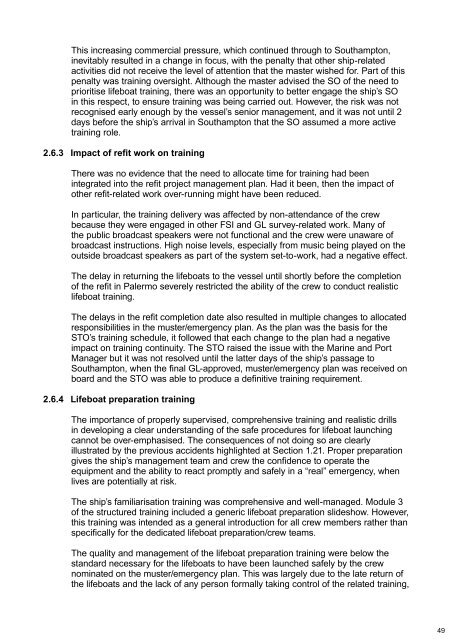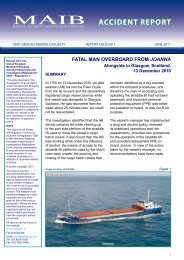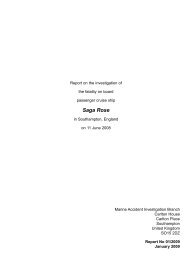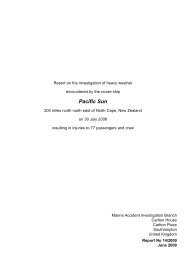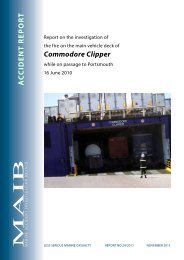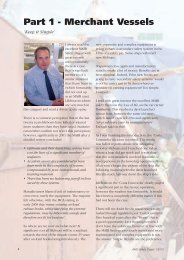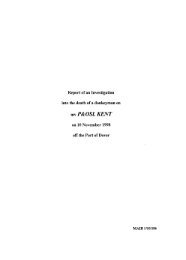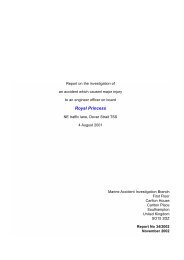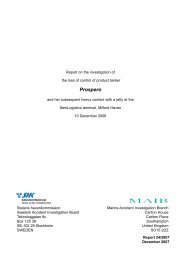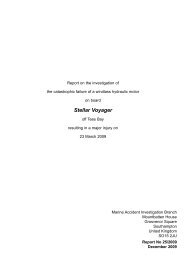SECTION 4 - Marine Accident Investigation Branch
SECTION 4 - Marine Accident Investigation Branch
SECTION 4 - Marine Accident Investigation Branch
Create successful ePaper yourself
Turn your PDF publications into a flip-book with our unique Google optimized e-Paper software.
This increasing commercial pressure, which continued through to Southampton,<br />
inevitably resulted in a change in focus, with the penalty that other ship-related<br />
activities did not receive the level of attention that the master wished for. Part of this<br />
penalty was training oversight. Although the master advised the SO of the need to<br />
prioritise lifeboat training, there was an opportunity to better engage the ship’s SO<br />
in this respect, to ensure training was being carried out. However, the risk was not<br />
recognised early enough by the vessel’s senior management, and it was not until 2<br />
days before the ship’s arrival in Southampton that the SO assumed a more active<br />
training role.<br />
2.6.3 Impact of refit work on training<br />
There was no evidence that the need to allocate time for training had been<br />
integrated into the refit project management plan. Had it been, then the impact of<br />
other refit-related work over-running might have been reduced.<br />
In particular, the training delivery was affected by non-attendance of the crew<br />
because they were engaged in other FSI and GL survey-related work. Many of<br />
the public broadcast speakers were not functional and the crew were unaware of<br />
broadcast instructions. High noise levels, especially from music being played on the<br />
outside broadcast speakers as part of the system set-to-work, had a negative effect.<br />
The delay in returning the lifeboats to the vessel until shortly before the completion<br />
of the refit in Palermo severely restricted the ability of the crew to conduct realistic<br />
lifeboat training.<br />
The delays in the refit completion date also resulted in multiple changes to allocated<br />
responsibilities in the muster/emergency plan. As the plan was the basis for the<br />
STO’s training schedule, it followed that each change to the plan had a negative<br />
impact on training continuity. The STO raised the issue with the <strong>Marine</strong> and Port<br />
Manager but it was not resolved until the latter days of the ship’s passage to<br />
Southampton, when the final GL-approved, muster/emergency plan was received on<br />
board and the STO was able to produce a definitive training requirement.<br />
2.6.4 Lifeboat preparation training<br />
The importance of properly supervised, comprehensive training and realistic drills<br />
in developing a clear understanding of the safe procedures for lifeboat launching<br />
cannot be over-emphasised. The consequences of not doing so are clearly<br />
illustrated by the previous accidents highlighted at Section 1.21. Proper preparation<br />
gives the ship’s management team and crew the confidence to operate the<br />
equipment and the ability to react promptly and safely in a “real” emergency, when<br />
lives are potentially at risk.<br />
The ship’s familiarisation training was comprehensive and well-managed. Module 3<br />
of the structured training included a generic lifeboat preparation slideshow. However,<br />
this training was intended as a general introduction for all crew members rather than<br />
specifically for the dedicated lifeboat preparation/crew teams.<br />
The quality and management of the lifeboat preparation training were below the<br />
standard necessary for the lifeboats to have been launched safely by the crew<br />
nominated on the muster/emergency plan. This was largely due to the late return of<br />
the lifeboats and the lack of any person formally taking control of the related training,<br />
49


